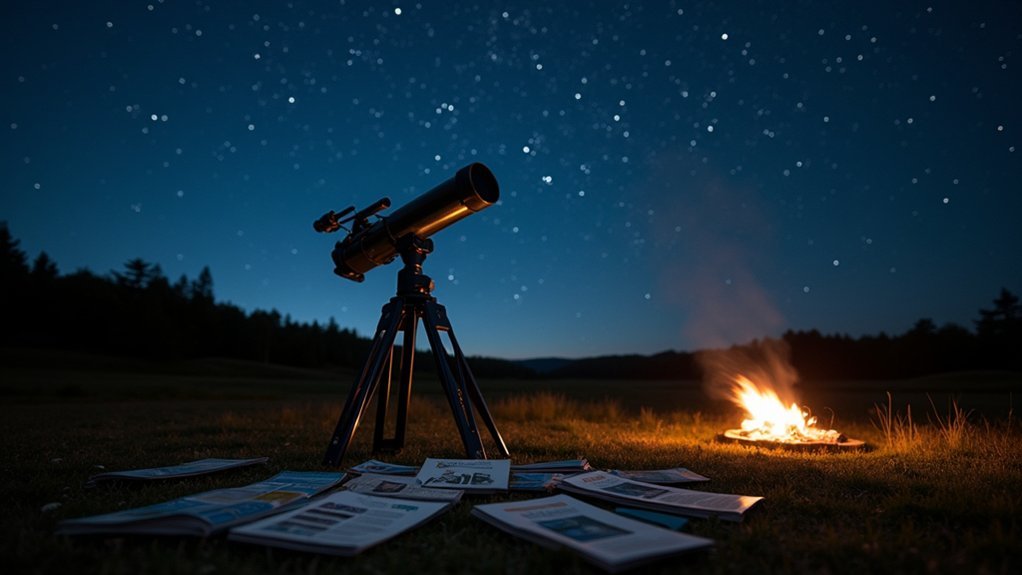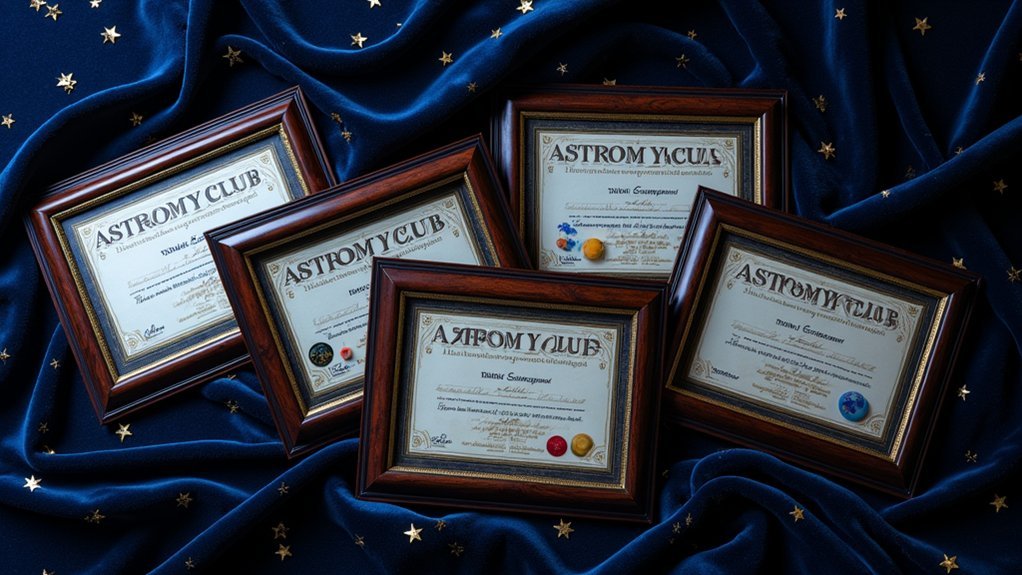To find planets tonight, look for bright objects that don’t twinkle like stars. Jupiter shines brilliantly in the west after sunset, while Venus dazzles as the morning “star” in the east before sunrise. Mars appears reddish, and Saturn glows with a steady yellowish light. Use mobile apps like Stellarium or SkySafari to identify planets in real-time. A pair of binoculars will enhance your view, revealing details invisible to the naked eye.
Essential Tools for Planet Hunting

Success in planet hunting begins with the right tools at your disposal. A star chart or sky map serves as your primary navigation guide, helping you identify planets and constellations with ease.
Pair this with quality binoculars to enhance your view of celestial objects—you’ll be amazed when Jupiter’s cloud bands and Saturn’s rings come into focus.
Download mobile apps like Stellarium or SkySafari to track planets’ positions and rise/set times in real-time.
Don’t forget a red flashlight, which preserves your night vision while you read charts or adjust equipment in the darkness.
For ongoing support, connect with local astronomy clubs or online forums where experienced stargazers share tips and organize group viewings.
These communities can dramatically accelerate your stargazing journey and make planet hunting more rewarding.
Understanding Planetary Motion in the Night Sky
When you’re looking for planets, you’ll need to understand that they follow predictable elliptical orbits around the sun, which causes their positions to shift gradually against the background stars over weeks and months.
You can track planets by noting their positions relative to familiar constellations and remembering that, unlike stars, planets don’t twinkle but shine with a steady light.
As Earth catches up to or moves away from other planets in their orbits, you’ll occasionally witness retrograde motion, where a planet appears to move backward in the sky for several weeks before resuming its normal eastward trek.
Orbital Paths Explained
Cosmic highways crisscross our solar system as planets travel along predictable elliptical paths around the Sun. When you’re tracking planets in the night sky, understanding these orbital paths helps you anticipate where to look.
Mercury zips around its tight orbit in just 88 days, while distant Neptune needs 165 years to complete a single revolution.
You’ll notice that planets don’t all move at the same speed or follow identical paths. Their visibility changes based on their position relative to Earth and the Sun.
Jupiter’s massive gravitational influence even alters nearby asteroid trajectories. When searching for planets, pay attention to planetary conjunctions—when two or more planets appear close together from your vantage point.
These alignments create spectacular viewing opportunities despite the planets being millions of miles apart in their respective orbital paths.
Planet Tracking Basics
Unlike the fixed stars that maintain consistent patterns, planets wander across our night sky in predictable yet dynamic paths.
To begin planet tracking, familiarize yourself with rise and set times, which vary throughout the month. The brightest planets, like Jupiter with its impressive -2.1 magnitude, are easiest to spot first.
For successful observations, timing is everything. Venus often dominates the evening sky after sunset, while Mars might require you to stay up until after midnight.
Use constellations as signposts—the Big Dipper can guide you to other celestial bodies. When planets reach their greatest elongation from the sun, they’re at ideal visibility.
Look for pairing opportunities, such as spotting Venus near Saturn, which creates memorable reference points for beginners developing their night sky navigation skills.
The Brightest Planets and How to Identify Them

As you scan the night sky, five planets stand out as the most accessible targets for beginning stargazers.
Jupiter dominates the western sky tonight with its brilliant -2.1 magnitude, remaining visible for about three hours after sunset. Look for reddish Mars almost overhead, shining at magnitude 0.6 and setting shortly after Jupiter.
Venus rules as the brightest “star” in the morning, rising in the eastern sky before sunrise. By month’s end, it’ll blaze at an impressive -4.7 magnitude.
During April evenings, you won’t find Venus, but late in the month, Saturn appears low in the east with its dimmer +1.2 magnitude.
Mercury reaches its greatest elongation on April 21, visible just above the eastern horizon shortly before sunrise.
Using Constellations as Celestial Signposts
Constellations serve as your natural map in the night sky, with zodiac patterns like Leo and Virgo helping you track the planets that travel along the ecliptic path.
You can master star hopping by using bright anchor stars like Regulus or Spica to navigate from familiar patterns to nearby planets, particularly when Mars or Jupiter appear in their vicinity.
As seasons change, you’ll notice different constellations dominate the evening sky, with spring showcasing the Big Dipper high overhead while summer brings the distinctive Teapot of Sagittarius into view.
Zodiac Constellation Basics
The zodiac provides a natural map in the night sky, offering beginner astronomers twelve distinct constellations that mark the sun’s yearly journey.
Starting with Aries in spring and ending with Pisces in winter, these astrological signs create a celestial highway where planets can always be found.
Learning to recognize distinctive shapes like Leo’s backward question mark or the balanced scales of Libra will dramatically improve your planet-hunting skills.
When searching for celestial objects, remember that planets only appear within this zodiac band. You’ll find Jupiter might be passing through Taurus one month and Gemini the next.
For effective navigation, observe which zodiac constellations are visible during specific seasons.
This knowledge allows you to quickly determine where to point your telescope when identifying planets in tonight’s sky.
Star Hopping Techniques
Steering through the night sky becomes considerably easier when you master the art of star hopping. Start with the Big Dipper, prominently displayed overhead in April, to locate Polaris. From there, trace lines to find Leo, identifiable by its backward question mark shape with bright Regulus at its base.
Use Regulus as your launching point to spot planets like Jupiter and Mars nearby.
For morning observers, look for the waning crescent moon on April 24-25, when it forms a triangle with Venus and Saturn, creating an unmistakable reference point.
During the Lyrid meteor shower (April 21-22), the bright star Vega in Lyra serves as both a meteor shower radiant and navigation marker.
When tracking the moon’s journey, the Teapot asterism in Sagittarius provides a helpful reference around April 18-19.
Seasonal Sky Patterns
Throughout the changing seasons, distinctive star patterns create reliable celestial signposts to guide your planetary hunt. April’s night sky offers exceptional celestial navigation opportunities using bright stars and constellations. The Big Dipper rides high overhead, pointing you toward Polaris and creating a framework for locating planets in the northern sky.
- Leo’s backward question mark contains Regulus, appearing near the waxing gibbous moon on April 7-8.
- Virgo’s bright star Spica positions itself above the full moon on April 11-12, marking the ecliptic where planets travel.
- Sagittarius’ Teapot asterism is visible near the moon on April 18-19, helping identify the rich star field where outer planets often reside.
While watching for the Lyrid meteor shower (April 21-22), use Vega as your anchor to scan for planetary movements.
Timing Your Observations for Optimal Viewing
Successful planet-hunting requires strategic timing, especially for beginners looking to maximize their chances of spotting celestial bodies.
Timing is everything for novice astronomers seeking their first glimpse of distant worlds.
In April, you’ll find Jupiter and Mars dominating the evening sky, with Jupiter setting about three hours after sunset by month’s end.
For morning observers, Venus offers prime viewing about an hour before sunrise early in the month, with improved visibility as April progresses.
Watch for Mercury’s greatest elongation on April 21, visible low on the eastern horizon shortly before sunrise.
Saturn’s ideal viewing occurs during the last two weeks, particularly around April 25 when a crescent moon appears nearby.
Don’t miss the Lyrid meteor shower peaking on April 21-22—your best viewing window extends from 10:30 PM until dawn under dark skies with minimal moonlight interference.
Common Challenges and Solutions for Beginners

While timing your observations is important, even the best-planned stargazing session can face unexpected hurdles.
You’ll likely encounter these common challenges when you’re just starting out:
- Light pollution interference – Choose a viewing location away from city lights during moonless nights to enhance visibility of celestial objects.
- Difficulty identifying planets – Remember planets don’t twinkle like stars. Use planetarium apps to help identify planets and track their positions in real-time.
- Missing ideal viewing windows – Plan around greatest elongations and oppositions when planets are brightest. Know rise and set times—for example, Jupiter sets about 90 minutes after twilight ends in late April.
Overcoming these obstacles will transform your frustrating first attempts into successful planet-spotting adventures, whether you’re scanning the evening or morning sky.
Beyond Naked Eye: Next Steps in Planet Observation
Once you’ve mastered spotting planets with your naked eye, you’re ready to dive deeper into the fascinating world of planetary observation.
Invest in binoculars or a small telescope to reveal Jupiter’s cloud bands and Saturn’s rings that remain hidden to the unaided eye.
The universe rewards patience—unlock hidden celestial details with even modest optical aid.
Enhance your navigation guide with a sky map to locate planets relative to constellations.
Track specific rise and set times—like Mars appearing at 12:14 a.m. and setting at 3:08 a.m. in April—to optimize your viewing schedule.
Combine your planetary observation with special events like the Lyrid meteor shower (peaking April 21-22) for a richer experience.
Finally, pay attention to moon phases; the new moon on April 27 creates ideal dark-sky visibility for fainter celestial objects that might otherwise be washed out.
Frequently Asked Questions
How to See Planets Align Tonight?
You’ll see Venus and Saturn aligned in the eastern sky before dawn, just 4 degrees apart. Look for Saturn about 5 degrees right of the crescent moon on April 24-25. Use binoculars for better visibility.
What Position Are the Planets in Right Now?
Right now, you’ll see Jupiter high in the western sky, Mars almost overhead, Venus rising in the east before sunrise, and Saturn appearing low in the eastern sky during the last half of April.
What Direction Do I Look for Jupiter Tonight?
Look to the western sky for Jupiter tonight. You’ll find it shining brightly about 15-20 minutes after sunset. It’s one of the brightest objects visible, and sets about three hours after the sun.
Where Can I Find the Planets in the Night Sky?
You’ll find Jupiter in the western sky after sunset, Mars overhead in Cancer, Venus in the eastern sky before sunrise, Mercury low on the eastern horizon pre-dawn, and Saturn near Venus in the east.
In Summary
You’re now equipped to find planets in the night sky! Remember to check astronomical calendars, use the right tools, and learn planetary patterns. Don’t be discouraged by initial challenges—each observation improves your skills. As you grow confident identifying Venus, Jupiter, Mars, and Saturn, you’ll find yourself automatically looking up each night, wondering which celestial neighbors are visiting your sky.





Leave a Reply